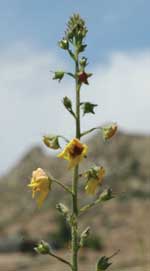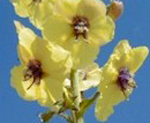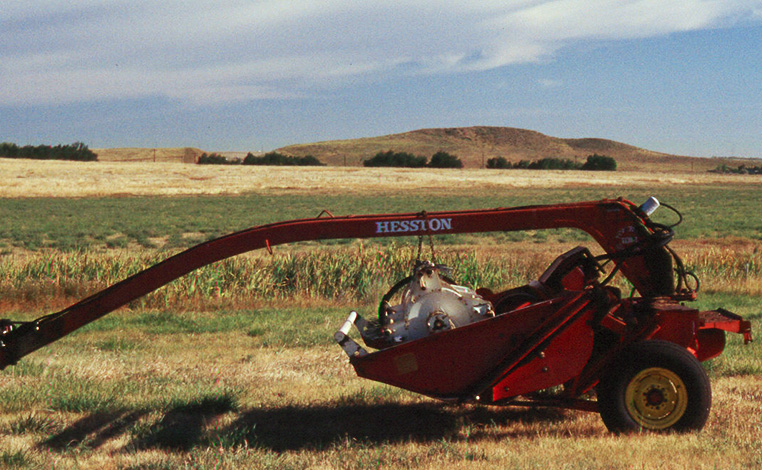Moth mullein
Verbascum blattaria L.
Keys to Identification
- Showy yellow to white flowers with purple centers.
This information courtesy of the Colorado Natural Areas Program
Family
Figwort ( Scrophulariaceae)
Other Names
Slippery mullein
USDA Code
VEBL
Legal Status
Colorado Noxious Weed List B
Identification
Lifecycle
Biennial
Growth form
Forb
Flower
Occur on the ends of the erect flowering stems that are produced during the second year of growth. Individual flowers are yellow to white, usually with some tinge of purple within. Flowers have 5 petals and each flower occurs on an individual flower stalk (peduncle).
Seeds/Fruit
A round capsule about 1/3 in wide. The capsule splits when mature into two cells filled with tiny dark brown seeds. The surface of each seed is marked with wavy ridges.
Leaves
Leaves initially develop as a basal rosette of leaves during the first year of growth and then occur alternately along the flowering stem during the second year of growth. Leaves are without hairs (glabrous), oblong, tapering to a point, with distinctly toothed margins.
Stems
Erect solitary (normally), or branching near the top, only slightly hairy in the upper portions, reaching 2-5 ft tall.
Roots
Taproot with fibrous root system.
Seedling
Cotyledons are spatula-shaped. First true leaves are oval with only slightly wavy margins. Subsequent leaves have more scalloped or toothed margins. Seedlings are very similar in appearance to common mullein but lack hairs.
Similar Species
Exotics
Other ornamentalVerbascums.
Natives
None known.
Impacts
Agricultural
Can be invasive in pastures and rangelands affecting forage quality and quantity. Moth mullein can occasionally be problematic in perennial cropping systems.
Ecological
Can be invasive in natural, rights-of-ways and neglected areas.
Habitat and Distribution
General requirements
Pastures, hay fields, rights-of-ways and abandoned areas preferring rich soils but will tolerate dry, sandy or gravely soils.
Distribution
Throughout the U.S. (excluding Alaska, Minnesota and Wyoming).
Biology/Ecology
Life cycle
Biennial
Mode of reproduction
Seed
Seed production
1000 capsules
Seed bank
90 years
Dispersal
Birds are reported to feed on and potentially distribute seeds.
References
The Ohio State University (n.d.) Moth Mullein. Retrieved 11/04/2005http://www.oardc.ohio-state.edu/weedguide/singlerecord.asp?id=760
USDA, NRCS. 2005. The PLANTS Database, Version 3.5 (http://plants.usda.gov). Data compiled from various sources by Mark W. Skinner. National Plant Data Center, Baton Rouge, LA 70874-4490 USA
Virginia Tech University. (n.d.) Moth Mullein: Verbascum blattaria. Retrieved 11/04/2005http://www.ppws.vt.edu/scott/weed_id/vesbl.htm
Whitson, T.D.(ed.), L.C. Burrill, S.A. Dewey, D.W. Cudney, B.E. Nelson, R.D. Lee, R. Parker. 1996. Moth mullien. Weeds of the West. Western Society of Weed Science, in cooperation with the Western United States Land Grant Universities Cooperative Extension Services, Newark CA.




